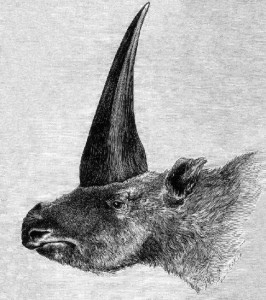MONDAY, 11 APRIL 2016

E. sibiricum is thought to have ranged from eastern Russia to Kazakhstan, their territory extending from the river Don to Mongolia.
In a paper published in February 2016 in the American Journal of Applied Science, researchers from Tomsk State University (TSU), Russia, and Pavlodar State Pedagogical Institute, Kazakhstan, described the new location of the fossil mammals, extending the species habitat range to the southeastern part of the West Siberian Plain. Though lacking teeth to accurately identify the specimen’s age and gender, the well preserved skull was estimated to belong to an elderly male, at a larger size than any previously discovered in Eastern Europe.
Researchers are questioning how this unicorn survived hundreds of thousands of years longer than other members of the species. “Most likely, the south of Western Siberia was a refúgium, where this rhino persevered the longest in comparison with the rest of its range,” suggested Andrey Shpanski, a paleontologist at TSU. “Or it could have migrated and lived for a while on the more southern areas”
Using radiocarbon dating methods in the 14CHRONO laboratory of Queen’s University, Belfast, researchers from TSU were able to date the well-preserved skull to the late Pleistocene, where crossing paths with humans was a possibility for these beasts. Humans were previously considered to have arrived the Siberian Arctic between 35,000 and 30,000 years ago, but evidence of a butchered mammoth carcass in 2012 pushed this estimate as far back as 45,000 years ago.
Currently, researchers are focusing on the environmental factors that played a part in the extinction of the species and the role migration played in its survival – concepts which may shed light on faunal migrations with contemporary climate change.
“Understanding of the past allows us to make more accurate predictions about natural processes in the near future,” said Shpansky.
